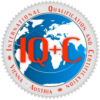
Personal Financial Planning
Stand out from the competition
with ISO 22222
 The quality standard for providing
The quality standard for providing
personal financial planning
One of the major issues reported by consumers when seeking financial
advice is the uncertainty over whether they can trust their financial planners.
With a vast number of investment schemes and financial planners to choose
from, consumers are often confused about where to turn for advice on
planning for their financial future.
The long awaited best practice standard has taken The International
Standards Organisation (ISO) and the British Standards Institution (BSI) seven
years to develop. The major trade and professional bodies, such as the FSA,
Institute of Financial Services, AIFA, The CII and the consumer group Which?
have played a pivotal role in the development of the standard.
ISO 22222 is aimed at increasing client confidence by providing an
internationally agreed benchmark for a high global standard of service. The
standard covers the ethical behaviour, competences and experience required
of a financial planner. This also enhances the transparency and efficiency of
the process for personal financial planning.
The ISO standard defines six steps of the personal financial planning process:
1. Establishing and defining the client and personal financial planner
relationship.
2. Gathering client data and determining goals and expectations.
3. Analysing and evaluating the client’s financial status.
4. Developing and presenting the financial plan.
5. Implementing the financial planning recommendations.
6. Monitoring the financial plan and the financial planning relationship.
Benefits to the Financial Planner :
Improved level of professionalism.
Gain a competitive edge.
Optimise their marketing and sales opportunities.
Improve their reputation and profile.
Attract and maintain a higher calibre of employee.
Advisers that have achieved the ISO 22222 have been rewarded with some of the following:
Improved performance and compliance.
More effective and user-friendly processes and documentation.
Standardisation of good working practices.
Improved communication (internally/externally).
An increase in company and personal profile.
Improved sales and marketing opportunities.
A reduction in professional insurance costs, due to the reduction in risks.


